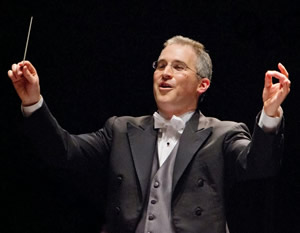Few cities the size of Greensboro can boast such an extensive series of free cultural events as those supported by The Music Center. Its Opus Concert Series fields several musical organizations including the Philharmonia of Greensboro, which ended its season with an all-Russian program. Music Director Peter Perret told the audience in Guilford College’s Dana Auditorium that since the current Russian leader is not so popular, he chose “From Csar to Soviet: Masterpieces from Russia” as the program’s title. Two of his selections are very seldom heard and would have made demands upon a professional orchestra, much less one made up entirely of volunteers with varying degrees of skill.
The Serenade in C Major for Strings, Op. 48, was composed back-to-back with the bombastic 1812 Overture in the fall of 1880 by Peter Ilyich Tchaikovsky (1840-93). He had little regard for the overture. David Fick, in his 2007 program note for the Los Angeles Philharmonic, quotes the composer: “But the serenade, on the contrary, I wrote from inner compulsion. This is a piece from the heart.” He went against precedence by shifting key dominance away from the outer movements to the inner two. The first of its four movements is an homage to Mozart; it is littered with double-stopping for violins and violas. The second movement is a delightful waltz. The third, marked “Elegia,” the heart of the work, is filled with gorgeous melodies. A melody based upon a Russian Folk tune, a “hauling song,” is given a thorough workout in the spirited finale.
Perret phrased the Serenade beautifully and controlled dynamics well. The Philharmonia is short of violins this season, and this contributed to a thinner than usual sound; there were sporadic intonation problems, especially in this opening work. The lower strings were much more consistent, with a good solid sound from the basses and cellos and heroic efforts from the three violas.
Unlike many Russian composers, such as Shostakovich, Rheinhold Glière (1875-1956) seems to have taken Csarist and Soviet dictatorship in his stride, turning out inoffensive, tuneful works that never asked questions. Treating the human voice extensively as an instrument in a concert piece is rare; Rachmaninoff’s Vocalise, Op. 34, comes to mind. Glière’s Concerto for Coloratura Soprano (1943), in two movements, makes considerable demands upon a singer possessing the highest, most agile voice set against a full orchestra. The voice is sometimes paired with or set against orchestral instruments.
Soprano Megan Cleaveland delivered the composer’s demands in spades despite having received the score on short notice. (A copy was finally obtained from the Duke University Library.) She is a first-year member of the A. J. Fletcher Fellows, and her ample operatic promise was reviewed in the UNC School of the Arts staging of Mozart’s La Finta Giardinieria. She lacked nothing in packing a lot of power behind her stratospheric peaks or in her ability to spin a controlled, seamless line. Her tone was warm and her intonation was precise. Perret balanced the orchestra with Cleaveland superbly. She managed her breathing nicely during louder orchestra-only episodes. Among several important instrumental pairings with Cleaveland, clarinetist Kenny Tysor played in both movements and flutist Chuck Coltrane was heard in the second. The woodwind and brass sections were impressive.
The Symphony No. 7 in C-sharp minor, Op. 131, of Sergei Prokofiev (1891-1953), was completed in 1952. It is sometimes called “the Children’s Symphony” because it was composed for and premiered as part of a radio program for children. When composing for children, such as was the case in Peter and the Wolf, the composer curtailed his fondness for dissonances and gave melodies more emphasis. The symphony is in four movements. The first movement juxtaposes a melancholy first theme in the violins with a second theme sung gorgeously by the cellos. The movement ends with the tick-tocking sounds of the glockenspiel and xylophone. The latter is repeated in the finale.
The second movement is a waltz that is by turns frisky and melancholic. The third movement is filled with heartfelt, singing melodies. The finale is mostly lively. The cello theme from the first movement is brought back in fuller orchestral splendor. There are two different versions of the conclusion. The original ending features the grim ticking from the first movement leading to a slow and quiet end.
In order to win the much needed 100,000 rubles of the Stalin prize, Prokofiev had been persuaded by the conductor Samuil Samosud to write a rousing ending. Both Stalin and Prokoviev died on the same day and, ironically, the composer won the Stalin prize four years after his death. Profofiev told Mstislav Rostropovich the original ending is the one he wanted to stand, but conductors face a choice. Perret used the quiet ending before for concerts in which the Symphony preceded another work. When it ends a concert, he prefers the showier ending in the published score, which tacks on a return of the finale’s opening material to evoke a more “uplifting” finale.
It was a treat to hear Symphony No. 7 barely a week after the North Carolina Symphony’s run of the composer’s Symphony No. 6. Perret lead a beautifully controlled performance. The violins were much more consistent throughout and the low strings were heroic. The brass and woodwinds were strong. Among a number of fine soloists were clarinetist Tysor, flutist Coltrane, and Jim Bain, English horn. This was a solid achievement for a community orchestra.











